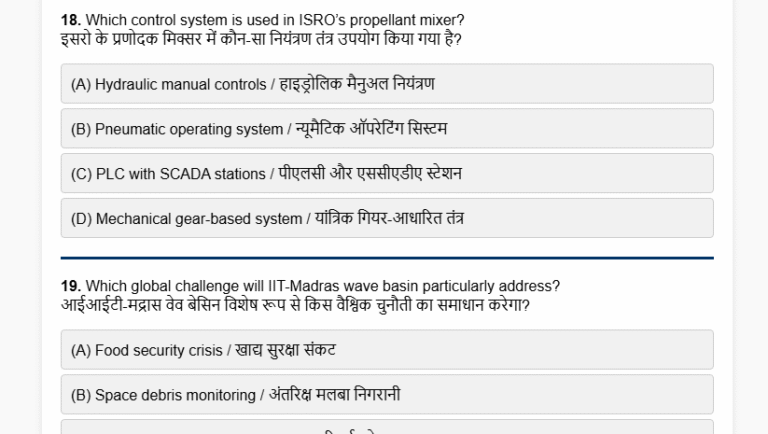Introduction
The 13th edition of the National Seed Congress (NSC) marked a significant event in India’s agricultural landscape, bringing together scientists, policymakers, industry representatives, and farmers. This annual event plays a crucial role in shaping the future of the seed sector and enhancing agricultural productivity and sustainability. The 13th National Seed Congress (NSC), with its theme “Innovating for a Sustainable Seed Ecosystem,” focused on fostering innovation, strengthening public-private partnerships, and promoting South-South collaboration to ensure food security and economic growth.
This detailed exploration covers the key highlights of the National Seed Congress (NSC), hybrid and biofortified crops, their significance, and the government’s initiatives for promoting sustainable seed production and distribution.
1. Overview of the 13th National Seed Congress
1.1 Theme: Innovating for a Sustainable Seed Ecosystem
The theme emphasizes the need to develop innovative seed technologies that are resilient, productive, and nutritionally rich. Given the growing challenges of climate change, food insecurity, and malnutrition, the focus is on developing stress-tolerant varieties, biofortified crops, and advanced breeding techniques.
1.2 Objectives of National Seed Congress (NSC)
- Enhancing Seed Technologies: Advancing research and technology to provide farmers with better seed varieties.
- Promoting Collaboration: Fostering cooperation among nations (South-South Collaboration) to share knowledge and resources in the seed sector.
- Public-Private Partnerships: Encouraging joint efforts between public institutions and private companies to enhance seed production and distribution.
- Farmer Welfare: Ensuring outcomes of discussions benefit farmers by improving access to quality seeds, enhancing productivity, and ensuring food security.
1.3 Importance of National Seed Congress (NSC)
- Platform for Dialogue: The NSC serves as a platform for exchanging ideas, innovations, and best practices in the seed sector.
- Policy Formulation: Insights gained from the congress inform government policies aimed at strengthening agricultural productivity.
- Farmer Empowerment: It addresses the challenges faced by farmers and provides them with solutions that enhance their livelihoods.
2. Key Highlights of the 13th National Seed Congress (NSC)
2.1 Innovative Seed Technologies
The congress emphasized the importance of innovative seed technologies to meet the demands of modern agriculture. Focus areas include:
- Hybrid Crops: Developing high-yield, disease-resistant, and climate-resilient hybrid crops.
- Biofortified Crops: Enhancing nutritional value in staple crops to address malnutrition.
- Stress-Tolerant Varieties: Seeds that can withstand extreme weather conditions such as drought, flooding, and high salinity.
- Accelerated Breeding Cycles: Using biotechnology and advanced breeding techniques to reduce the time needed to develop new seed varieties.
2.2 South-South Collaboration
South-South Collaboration in the seed sector focuses on sharing knowledge, technologies, and resources among developing countries. This collaboration aims to:
- Enhance seed diversity.
- Develop joint seed research programs.
- Improve access to high-quality seeds in regions with similar agro-climatic conditions.
- Promote economic growth through mutual cooperation.
2.3 Public-Private Partnerships (PPPs)
Public-Private Partnerships play a critical role in the seed sector by combining the strengths of public research institutions and private enterprises. Key benefits of PPPs include:
- Research and Development: Collaborative R&D efforts to create better seed varieties.
- Distribution Networks: Expanding the reach of quality seeds to farmers through efficient distribution channels.
- Innovation: Encouraging investment in cutting-edge seed technologies.
2.4 State Government Support
The outcomes of the National Seed Congress (NSC) will be implemented with full support from the state governments to ensure:
- Food Security: Ensuring availability of nutritious and high-yielding crops.
- Economic Growth: Boosting agricultural productivity to support rural economies.
- Farmer Welfare: Providing farmers with access to quality seeds and technology to improve their livelihoods.
3. Hybrid Crops: Enhancing Productivity and Resilience
3.1 What Are Hybrid Crops?
Hybrid crops are developed by crossbreeding two genetically different parent plants to produce offspring with desirable traits. This process is called hybridization.
3.2 Objectives of Hybrid Crops
- Increased Yield: Hybrid crops often produce higher yields compared to traditional varieties.
- Disease Resistance: Improved resistance to pests and diseases.
- Drought Tolerance: Ability to withstand water-scarce conditions.
- Improved Quality: Better nutritional content, taste, or storage properties.
3.3 Concern with Hybrid Crops
- Seed Dependence: Hybrid crops do not produce seeds that retain the parent plant’s beneficial traits. As a result, farmers need to buy new seeds each planting season.
- Cost Factor: Continuous purchase of seeds can be costly for small and marginal farmers.
4. Biofortified Crops: Fighting Malnutrition
4.1 What Are Biofortified Crops?
Biofortified crops are specially bred to have higher concentrations of essential nutrients such as vitamins, minerals, or amino acids. This is achieved through:
- Traditional Breeding: Selective breeding of nutrient-rich plant varieties.
- Genetic Modification: Altering the plant’s genetic makeup to enhance nutritional content.
- Biotechnological Methods: Using advanced scientific techniques to improve nutrient profiles.
4.2 Objectives of Biofortified Crops
- Combating Malnutrition: Providing essential nutrients in regions where deficiencies are prevalent.
- Health Improvement: Reducing the incidence of diseases related to nutrient deficiencies.
- Food Security: Enhancing the nutritional quality of staple crops.
4.3 Examples of Biofortified Crops
- Golden Rice: Genetically modified to produce higher levels of provitamin A (beta-carotene) to combat vitamin A deficiency.
- Iron-Rich Beans: Bred to contain higher iron content, addressing anemia and iron deficiency.
- Zinc-Enriched Wheat: Developed to provide higher levels of zinc, crucial for immune function and child development.
4.4 Merits of Biofortification
- Sustainable Solution: Provides nutrients naturally through food crops, making it a sustainable approach to tackling malnutrition.
- Affordability: Biofortified foods are cost-effective since they do not involve additional price hikes.
- No Yield Loss: Biofortified varieties are as high-yielding as traditional crops, ensuring no loss in productivity for farmers.
- Low Infrastructure Requirement: Unlike food fortification, biofortification does not require elaborate processing facilities.
- Farmer-Friendly: No additional costs are incurred for preparing enriched food grains.
4.5 Key Differences Between Hybrid and Biofortified Crops
| Aspect | Hybrid Crops | Biofortified Crops |
|---|---|---|
| Focus | Improving traits like yield, resilience | Enhancing nutritional content |
| Method | Crossbreeding different varieties | Traditional breeding, genetic modification |
| Benefit | Higher yield, disease resistance | Improved nutrition, reduced malnutrition |
| Concern | Need to buy new seeds annually | No additional cost for enriched food |
5. Government Initiatives for Sustainable Seed Production and Distribution
5.1 National Seed Policy (2002)
- Objective: Encourage both public and private sectors to increase seed production, improve quality control, and ensure efficient seed distribution.
Key Features:
- Facilitates the availability of high-quality seeds.
- Encourages seed certification to maintain standards.
- Supports research and development in seed technology.
5.2 National Gene Bank
- Purpose: Conserve the genetic diversity of crops for future generations.
Significance:
- Preserves traditional and indigenous seed varieties.
- Provides a repository for research and development of new seed varieties.
5.3 State Seed Banks
- Objective: Support local farmers by preserving native seeds and facilitating seed exchange programs.
Benefits:
- Encourages seed diversity.
- Provides farmers with access to region-specific seeds.
5.4 National Food Security Mission (NFSM)
- Goal: Increase the production of staple crops like rice, wheat, and pulses.
Focus:
- Promotes the use of high-quality seeds to enhance productivity.
- Supports sustainable farming practices to ensure long-term food security.
5.5 Pradhan Mantri Krishi Sinchayee Yojana (PMKSY)
- Objective: Improve water-use efficiency in agriculture.
Relevance to Seeds:
- Encourages the use of climate-resilient seeds for water-scarce regions.
- Supports the adoption of stress-tolerant varieties to mitigate drought risks.
5.6 National Mission on Organic Farming (NMOF)
- Purpose: Promote organic farming practices.
Seed Focus:
- Encourages the production of organic seeds.
- Provides subsidies for organic inputs and seed-saving techniques.
5.7 Farmer-Producer Organizations (FPOs)
- Role: Empower farmers by facilitating the production and distribution of locally adapted seeds.
Benefits:
- Enhances farmer involvement in seed systems.
- Promotes seed diversity and resilience.
6. Challenges and Future Directions
6.1 Challenges in Seed Sector
- Dependence on Hybrid Seeds: Continuous purchase of hybrid seeds can burden small farmers.
- Infrastructure Gaps: Limited access to seed storage and processing facilities in rural areas.
- Climate Change: The increasing frequency of extreme weather events necessitates the development of resilient seed varieties.
- Knowledge Gaps: Limited awareness among farmers about the benefits of biofortified and hybrid seeds.
6.2 Future Directions
- Strengthening Research: Invest in research to develop seeds that are climate-resilient and nutritionally enriched.
- Farmer Education: Conduct training programs to educate farmers on the use of innovative seed technologies.
- Expanding PPPs: Encourage more public-private partnerships to enhance seed production and distribution.
- Policy Support: Implement supportive policies that facilitate access to quality seeds for all farmers.
Conclusion
The 13th National Seed Congress highlighted the importance of innovation, collaboration, and sustainable practices in the seed sector. By focusing on hybrid and biofortified crops, stress-tolerant varieties, and accelerated breeding cycles, the congress aimed to address the challenges of modern agriculture. Government initiatives such as the National Seed Policy, National Food Security Mission, and Farmer-Producer Organizations play a critical role in promoting sustainable seed production and distribution.
Ensuring food security, enhancing farmer welfare, and tackling malnutrition require a concerted effort from policymakers, scientists, and farmers. The vision set forth by the National Seed Congress (NSC) provides a roadmap for a resilient and sustainable agricultural future in India.
Daily Mains Practice Questions
UPSC (CSE) Mains Questions on National Seed Congress and Seed Sector
1. Essay-Type Questions
| [Q1.] “Innovating for a Sustainable Seed Ecosystem is key to ensuring food security and farmer welfare in India.” Discuss in light of the 13th National Seed Congress. |
| [Q2.] “Hybrid and biofortified crops offer solutions to modern agricultural challenges, but also pose new concerns.” Critically analyze this statement. |
| [Q3.] Examine the role of public-private partnerships in the seed sector in promoting sustainable agriculture in India. |
| [Q4.]“South-South Collaboration in the seed sector can enhance food security and economic growth among developing countries.” Elaborate with suitable examples.. |
2. General Studies Paper 1: Indian Society
| [Q1.] Discuss the importance of biofortified crops in addressing malnutrition in India, particularly in rural and underserved regions. (250 words) |
| [Q2.] Examine how hybrid crops have transformed Indian agriculture and highlight the challenges associated with their use. (250 words) |
3. General Studies Paper 2: Governance and Policies
| [Q3.] Evaluate the role of government initiatives like the National Seed Policy (2002) and National Food Security Mission (NFSM) in promoting sustainable seed production and distribution. (250 words) |
| [Q4.] Discuss the role of Farmer-Producer Organizations (FPOs) in enhancing seed diversity and empowering farmers. (250 words) |
| [Q5.] Analyze the significance of State Seed Banks in preserving traditional seed varieties and supporting local agriculture. (250 words) |
| [Q6.] How does the Pradhan Mantri Krishi Sinchayee Yojana (PMKSY) support the use of climate-resilient seeds in water-scarce regions? (250 words) |
4. General Studies Paper 3: Economy and Agriculture
| [Q7.] What are hybrid crops, and how do they contribute to enhancing productivity and resilience in Indian agriculture? Discuss the associated concerns.? (250 words) |
| [Q8.] Explain the process and benefits of biofortification. How can biofortified crops help address micronutrient deficiencies in India? (250 words) |
| [Q9.] Analyze the impact of public-private partnerships in developing and distributing quality seeds. How can these partnerships be strengthened for the benefit of small and marginal farmers? (250 words) |
| [Q10.] Discuss the need for accelerated breeding cycles and innovative seed technologies in the context of climate change and food security. (250 words) |
| [Q11.] Evaluate the importance of South-South Collaboration in the seed sector for ensuring global agricultural sustainability. (250 words) |
5. General Studies Paper 4: Ethics, Integrity, and Aptitude
| [Q12.] Discuss the ethical considerations in promoting hybrid seeds that require farmers to purchase new seeds each season. (250 words) |
| [Q13.] How can biofortified crops reflect ethical principles in addressing malnutrition and ensuring equitable food distribution? (250 words) |
Frequently Asked Questions (FAQs)
1. What is the National Seed Congress (NSC)?
Answer:—
The National Seed Congress (NSC) is an annual event that brings together scientists, policymakers, industry representatives, and farmers to discuss and promote innovations in the seed sector. The focus is on improving seed quality, fostering collaboration, and ensuring food security.
2. What was the theme of the 13th National Seed Congress?
Answer:—
The theme of the 13th National Seed Congress (NSC) was “Innovating for a Sustainable Seed Ecosystem.” This theme emphasizes the need for new technologies, public-private partnerships, and sustainable practices to strengthen the seed sector.
3. What are hybrid crops?
Answer:—
Hybrid crops are produced by crossbreeding two genetically different parent plants to combine desirable traits, such as higher yield, disease resistance, and drought tolerance. However, hybrid seeds often do not retain these traits in subsequent generations.
4. What are the benefits of hybrid crops?
Answer:—
The benefits of hybrid crops include:
- Higher yields: Increased productivity compared to traditional varieties.
- Disease resistance: Improved resistance to pests and diseases.
- Climate resilience: Better adaptation to drought, heat, and other stress conditions.
5. What are biofortified crops?
Answer:—
Biofortified crops are specially bred to contain higher levels of essential nutrients like vitamins and minerals. This is done through traditional breeding, genetic modification, or modern biotechnological methods to address malnutrition.
6. How do biofortified crops help in addressing malnutrition?
Answer:—
Biofortified crops help by:
- Providing essential nutrients naturally through daily diet.
- Reducing the prevalence of nutrient deficiencies, especially in rural areas.
- Offering a sustainable and cost-effective solution to malnutrition.
7. What is the key difference between hybrid and biofortified crops?
Answer:—
- Hybrid Crops: Focus on improving traits like yield, resilience, and disease resistance.
- Biofortified Crops: Focus on enhancing nutritional content to address deficiencies.
8. What are some examples of biofortified crops?
Answer:—
Examples include:
- Golden Rice: Enhanced with provitamin A (beta-carotene) to combat vitamin A deficiency.
- Iron-Rich Beans: Contain higher iron levels to reduce anemia.
- Zinc-Enriched Wheat:Provides higher zinc content to boost immunity.
9. What is South-South Collaboration in the seed sector?
Answer:—
South-South Collaboration involves developing countries cooperating to share knowledge, resources, and technologies in the seed sector. This collaboration helps enhance agricultural productivity and food security among nations with similar challenges.
10. How does the government support sustainable seed production?
Answer:—
The government supports sustainable seed production through initiatives like:
- National Seed Policy (2002): Promotes quality seed production and distribution.
- National Gene Bank: Conserves genetic diversity of crops.
- National Food Security Mission (NFSM): Promotes high-quality seeds for staple crops.
- Pradhan Mantri Krishi Sinchayee Yojana (PMKSY): Encourages climate-resilient seeds.
- Farmer-Producer Organizations (FPOs): Facilitate local seed production and distribution.
11. What is the role of public-private partnerships (PPPs) in the seed sector?
Answer:—
Public-private partnerships (PPPs) help by:
- Combining resources for research and development.
- Expanding distribution networks for quality seeds.
- Promoting innovation in seed technologies to benefit farmers.
12. What challenges do hybrid crops pose to farmers?
Answer:—
Challenges include:
- Seed Dependence: Farmers need to buy new seeds each season because hybrid seeds do not retain traits.
- Cost Burden: Continuous seed purchase can be expensive for small and marginal farmers.
13. Why is the National Gene Bank important?
Answer:—
The National Gene Bank is important for:
- Preserving Crop Diversity: Conserves traditional and indigenous seed varieties.
- Future Research: Provides genetic resources for developing new seed varieties.
14. How do biofortified crops compare to food fortification?
Answer:—
Biofortified crops provide nutrients naturally through crops, whereas food fortification involves adding nutrients during food processing. Biofortified crops are more sustainable and do not require additional infrastructure.
National Seed Congress National Seed Congress National Seed Congress







